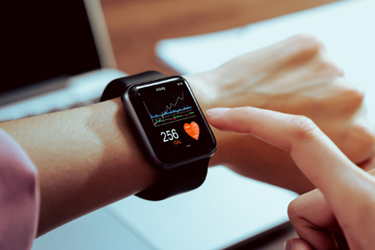How Is The Medical Wearable Landscape Evolving With Advanced Tech?
A conversation with Jacob Skinner and Will Berriss, Thrive Wearables

Conventional medical devices have revolutionized patient diagnostics and treatments and improved quality of life across a staggering breadth of applications. Applying software techniques, including data science, machine learning (ML), and general artificial intelligence (AI), has many ethical and regulatory dimensions. However, the future is heading rapidly toward a point where these techniques are driving a new wave of innovation and positive health impacts.
Wearable technology is advancing at a rapid pace and with this advancement comes the opportunity to capture a very different kind of continuous health data than that recorded in a hospital setting. How do we combine incredible new sensing technologies with robust software to take full advantage of the opportunity for intelligent, safe personal health monitoring?
Jacob Skinner is the CEO of Thrive Wearables, where he uses wearable technology to improve healthcare and democratize access to it. He completed a D.Phil. in experimental physics and has designed human-centered technology for over 10 years. He has designed commercially available electrophysiology sensors and applications at the University of Sussex's Sensor Technology Research Centre.
Will Berriss is a software engineer with over 20 years of experience in the field. He is a Chartered Engineer (CEng) and member of the Institution of Engineering and Technology (MIET) and has a Ph.D. in medical image processing.
What is your view on the current medical wearable device landscape?
 Skinner: In the past, medical devices were things that we just used in hospitals and in doctors’ offices. What we see now is what I call the consumerization of medical devices, in which they are still medical device certified and built within strict standards, but they are not necessarily life critical; they are more geared to monitoring, remote patient care, and in supporting virtual wards.
Skinner: In the past, medical devices were things that we just used in hospitals and in doctors’ offices. What we see now is what I call the consumerization of medical devices, in which they are still medical device certified and built within strict standards, but they are not necessarily life critical; they are more geared to monitoring, remote patient care, and in supporting virtual wards.
It’s a testament to advances in the industry, because these medical devices can be used by people on their own terms and they are much more accessible. They're not as cumbersome physically or as complex to use. What is really interesting as well is the way in which this is happening and the potential in this space. For example, the Apple Watch is a consumer electronics device, but under very particular conditions it's also a medical device, measuring specific ECG signals. It's still clear from a regulatory point of view which devices are medical and which are not, but for the user the boundaries are increasingly broad.
 Berriss: It feels like the current landscape is not quite there yet. We're sort of dipping a toe in the water, but it would be great if apps and devices could become more heavily standardized and adopted. For this to happen, the measurements that tech could generate would need to be delivered to clinicians and be considered reliable for care.
Berriss: It feels like the current landscape is not quite there yet. We're sort of dipping a toe in the water, but it would be great if apps and devices could become more heavily standardized and adopted. For this to happen, the measurements that tech could generate would need to be delivered to clinicians and be considered reliable for care.
This could result in more personalized healthcare and treatment that is even more tailored to a patient.
How do you see the use of data science, machine learning, and AI revolutionizing the wearable tech industry?
Skinner: There's a natural dissonance between medical devices and artificial intelligence that is tricky to navigate from a medical risk point of view. From a regulatory perspective, it's very hard to use dynamic algorithms because of the diversity of outcomes they might lead to, so you have to constrain the models very carefully and ensure outcomes are within specified boundaries.
Berriss: The way I see things, there is a lot of data being captured by private companies but, going forward, some or all of that data could be made available centrally, and by centrally I mean the NHS in the U.K or, perhaps Medicare or Medicaid in the USA. A huge amount of data processed intelligently about one thing, say a tumor, or even in relation to multiple patients, could give a much better understanding of the boundary of the tumor, and, for example, how quickly it may or may not grow, which ultimately helps those managing it to make informed decisions.
Could these techniques drive a new wave of innovation?
Skinner: Yes. That's the core of it. These opportunities exist because of wearable technology and advances in sensors, which broaden the concept of medical devices. For example, tumor scanning has always been data heavy, but the breadth of what data is relevant now is definitely changing.
Nobody used to know how many steps they took in a day; now it’s something most of us are aware of and can easily find out, and you can derive some basic stuff relating to exercise, but then you can take that so much further. For example, you could be measuring heart rate constantly. If you're at risk of heart disease or heart failure and there was a chance that you might be able to detect it just that little bit earlier, I think that's where the bigger opportunities are, in these big burdens on the NHS and big causes of death. But knowledge isn’t always a good thing, and you can’t just give people information that alarms them or that they can’t interpret properly, but you also can’t shield them from their rights to be informed. Ultimately, if you can predict that someone is going to get ill, that’s a whole other resource requirement.
Berriss: Definitely, these techniques are being used in the financial world and in engineering and space, for example. As more AI and data science work happens, and it becomes more popular, more of those insights and improvements will get generated and there will be more and more that is relevant to the health industry.
If you had a room full of people and half were healthy and some had a heart condition and then you go and take some measurements – and that’s the whole point, really, because the pattern could be in the data somewhere we don’t know about already – AI would typically spot those differences in the data that might not be visible on the face of it. And that’s where it becomes really interesting – pattern recognition and solving things that humans can’t.
How do you envisage this technology being used to improve people’s health?
Skinner: There are so many answers here! Let's start with democratization. If people are looking after their own health, then that's a great starting point, because health professionals cannot look after everyone at all times. First, these devices could start constantly measuring users’ health and feeding information back to users and potentially escalating to medical professionals as needed. That's kind of the bread and butter win in terms of wearable tech, constant data, and predictive and preventive healthcare.
So, for example, is somebody moving in the wrong direction and is two years away from a heart attack? Having that kind of insight would be incredibly beneficial in order to have two years’ worth of a mitigation strategy and to empower patients to take ownership of their physical health and make informed lifestyle choices. In regard to virtual wards and remote patient monitoring, it’s blurring the boundary between hospitals and homes, so I think the real advances will be in semi-medical technologies or monitoring devices that are not critical care but are really good at predictive care.
Berriss: I think it would improve people's health by involving them more. Currently, you can take your blood pressure at home, and when you go to see a clinician you could provide an attachment with vitals data from the last week. But it depends on whether we can get to a point where certain approaches to measuring health signals can be so standardized that users and medical professionals can feel confident in the validity of the data. This obviously needs regulating, so this data is medically useful and doesn’t need to be replicated afterward, and that’s the gap that needs closing.
How can software be made safe and secure enough for it to be used in the continuous monitoring of personal physiological data?
Berriss: Safety and security ultimately comes down to encrypting data and being careful with the way in which you share it and also how you share it, especially with continuous monitoring. There is a lot of progress in this already happening, with companies like Apple, which has encrypted the Apple Watch so it cannot connect with just any Bluetooth device to retrieve data from it. So, in some respects, what we need is already possible, but on the flip side is whether this can be legally proven. Would it hold up in a court of law that we have proof the data hasn't been tampered with or been placed into the wrong hands?
Skinner: Medical software has to be highly validated and tested, as it's much more conservative in terms of what it's connecting to, how it's processing data, who's got access to it; essentially, it's all much more of a sandbox. So, there's a general additional cost and time investment required in medical software processing physiological data. I believe that an even more crucial question to consider is how data can be managed and stored securely, given that it contains valuable personal information that is at risk of being misused. The value of this data is enormous if it is used appropriately, but there is also a significant risk.
The concept of ownership through a blockchain or other associated access protocols is fascinating. When combined with encryption and health records, it creates a very interesting space. I believe that this combination will become increasingly important and have a significant impact in the near future. In addition, if individuals have more data and want to access it on their own terms for their own healthcare reasons, they may need to be given controlled access to other people's aggregated data on certain terms to compare their data and make conclusions. This represents a need for a sea change in how data is currently used, which is extremely top-down and stored in big databases with limited access. It is not easy to shift data around or gain insights from it, and it is not currently being used in a way that could be incredibly useful.
Furthermore, there is the potential for buying and selling of data in a way that respects privacy and anonymity, which could be useful for research purposes. However, this is not being done openly or on a large scale yet.
Berriss: One way to anonymize the data could be by generating random number codes assigned to users instead of real names. In the COVID-19 tracking apps, they used a number code to identify people instead of their real names, and this could be potentially one avenue to follow. So, it’s not impossible, it just needs more work.
What are the ethical and regulatory dimensions at play here?
Berriss: I suppose using a blockchain to keep things secure and establish contracts between individuals and companies or medical bodies is important from an ethical perspective. For many years, people have been concerned about their personal data being used against them. For example, if you measure certain health metrics and discover that you are predisposed to a condition that could lead to your death in 10 years, you may not want this information to be shared with your health insurance company because they could deny you coverage for known or predicted conditions.
Therefore, it is crucial for individuals to understand the potential implications before using devices that track their health data. It is important for companies to disclose up front what kind of information they may discover and with whom they may share this information. This is especially true for individuals who are more vulnerable and may have health data that could lead to negative consequences.
Skinner: Yes, this is a critical issue. If we don't implement proper measures to secure personal data using a blockchain and other technologies, it is highly likely that this information will be vulnerable to hacking. The consequences of such breaches could be severe, especially for healthcare agencies like the NHS. In terms of regulation, I think there are two different issues taking place. The first is the exponential increase in the amount of data that is being accessed and stored in various databases. This increase in data flow is causing a problem, as there is a million times more data and millions of different nodes. The concern is how this data is being accessed and stored and the potential risks associated with it.
The second issue is related to the relaxation of medical standards. While there may be good reasons for this relaxation, there is a risk associated with it. The FDA is allowing many technologies to pass that traditionally wouldn't have. Examples could include many digital solutions that have come into being due to the emergence of mobile phones. These digital systems are usually classified outside of the more stringent medical device regulations (under what is called a 510k submission), as well as a myriad of Class I and II devices, which are essentially just sensing and passing on the information in a qualified way. Taking this to the extreme leads to what are often termed “wellness” devices, which are very much positioned (in the market) as non-medical in nature. This creates a moving target in terms of what medical efficacy is and what medical technology credibility is. It's hard to know quite where the line is, and there's a strong chance that technology advances and regulation will not be well aligned most of the time. This is a nuanced discussion, but it's important to be aware of the potential implications of fast-tracked technologies in the medical field.
What challenges do you see in the integration of these technologies into wearable devices and their apps?
Berriss: I think the key difficulties with integrating with anything we've discussed on the technical side lies in the sheer amount of data involved. First, there are network bandwidth issues that need to be maintained if you want to transmit the data elsewhere, and if you don't, then you'll need to process it locally, which presents its own set of challenges. It's often not feasible to transmit such large amounts of data.
If you integrate into a mobile application, while mobile phones are capable of handling complex tasks, there are still challenges with what works, for example, what processing you do and what data will be transmitted. There also may be a question about what appetite users have for a device that's so powerful, which could also impact how such a device is created and define what form it takes.
Skinner: I believe the main challenge lies in proving the value of wearable technology. The equation that relates the value of using the technology to the friction it creates is well recognized. Essentially, if someone perceives a lot of value from using a piece of technology, they are more likely to adopt it. However, human-centered technologies that require close proximity can be quite invasive to personal space, making it difficult to overcome this barrier. Therefore, in order to encourage adoption, the value of the technology must be proven to be very high.
Even in cases where it could mean the difference between life and death, such as with wearable technology that could detect a potential heart attack, people may still resist using it if it feels too bulky or obtrusive. Additionally, even if the technology alerts them to a potential health issue, they may not take action to address it. In short, the biggest challenge is improving the adoption of wearable technology by increasing its value beyond the friction it creates.
What’s next in this area? Please give us your predictions.
Skinner: Essentially, I would say more of what we've already discussed. The themes we talked about all have timelines. These include the democratization of healthcare, using preventive and predictive measures for people to better understand and engage with their health, and reducing the number of hospital visits through these measures. Additionally, helping people go home sooner by utilizing virtual wards and remote monitoring are the key predictions.
Berriss: In my experience, I find you tend to know what's going to be the next big thing when you hear it as a recurring topic in the media or in this space. For example, I’ve seen many discussions about heart rate and heart rate variability. If you ask me what's immediately next, I would say something in that space.
